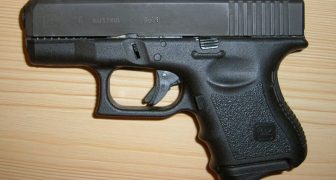This is a guest post by Andrew Betts
Does it seem like there are more gimmick rounds introduced lately or is just me? It may have always been this way,  but it really feels as though there has been a sudden proliferation of manufacturers selling magical beans to unsuspecting firearm owners. Maybe it is the sudden proliferation of new shooters due to the political climate that caused it. Whatever the cause, there is no shortage of snake oil.
but it really feels as though there has been a sudden proliferation of manufacturers selling magical beans to unsuspecting firearm owners. Maybe it is the sudden proliferation of new shooters due to the political climate that caused it. Whatever the cause, there is no shortage of snake oil.
This time around we’ll take a look at OATH Tango. First, the reason “OATH” is in all caps is not just to yell at you. It is an acronym which stands for “Operator’s American Tactical Hardware”. Honest. You can’t make this stuff up. I’m sure it sounded wicked cool when they came up with it, though. Their Tango line is an all copper machined bullet like those made by Lehigh and Grizzly Extreme.
Being solid copper, the projectile weight is lower than you would expect for .45 Auto but the velocity is consequently higher. It does function as designed, with the petals opening perfectly. The expanded diameter really is impressive. It doesn’t pass through the tissue facing forward, though. Shortly after expansion, uneven drag and a center of gravity at the rear of the projectile inevitably cause it to turn sideways, cutting substantially less tissue than you might think. It ultimately comes to rest at only 9.4 inches. That falls terribly short of the FBI recommended 12” minimum. The reason for that minimum is beyond the scope of this article. If you are unsure of why that is the minimum, know that smarter men than you or I established that standard by examining literally thousands of actual shootings. If you haven’t read “Handgun Wounding Factors and Effectiveness”, you should. (http://gundata.org/images/fbi-handgun-ballistics.pdf) For now, understand that if a projectile fails to pass that mark, it matters very little how well in performs in other ways.
It is true that the .35 caliber tip of the bullet passed the 12” threshold, but this is simply meeting the penetration standard by technicality. It is not enough for a portion of the bullet to reach the mark, if that portion is too small to cause significant bleeding and bring about quick incapacitation. The purpose of the minimum penetration standard is to ensure that a projectile can reach and cause significant damage to vital organs.
Regardless of the technical reasons, if a new pistol load seems to be revolutionary and seems to cause far more damage than typical jacketed hollow point handgun loads would normally do, that should give you pause. As Heinlein said, “There ain’t no such thing as a free lunch.” Handgun loads do not cause devastating damage and never will. Pistols are not powerful, they’re portable. They make significant compromises in range, accuracy, and power to be small enough to keep conveniently on our person. As always, magical wizard ammo doesn’t make up for a training deficiency. While selecting quality JHP for your carry gun is important, training is more important.
Andrew Betts served with the Arizona National Guard for over 12 years, including a tour to Afghanistan. Visit his YouTube Channel for more great shooting information.
Photo Credit – Andrew Betts


Speak Your Mind